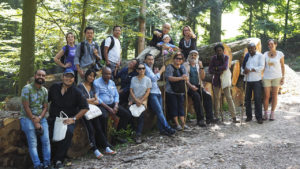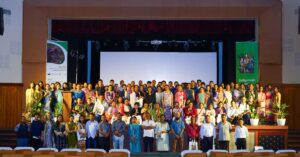
Sensory workshops help us understand more about the food that we consume. An education in taste will bring us to recognize and interpret sensory stimuli which will, in turn, create awareness in our food choices.
While taste is thought to be the most important sense when eating, it isn’t so. The fact is that we use all of our five senses when we eat; the sense of sight, hearing, touch, taste and smell. Think about the aroma of coffee or the texture and tactile sensations one feels when eating ice cream or the crispness when biting into an apple, also attributed to hearing. As for ‘sight’, it is surely the first thing that attracts us to food.
The perception of the environment which surrounds us and that of food is always linked to the existing triggers of multiple sensory stimuli which are then interpreted based on past experience. In the case of food, for example, even though one sense might sometimes dominate over others, the profile which we perceive is the result of the combined action of the senses. However to recognized and appreciate the quality of a food, it is beneficial to learn how to interpret different sensory stimuli individually.
SIGHT
It has been estimated that 80% of the information which reaches our brain comes from the visual stimuli. The organ of sight is the eye. The visual attributes of a food product like shape, appeal of the packaging and above all the colour play a very important role in its commercial success.
SMELL
The sense of smell is the oldest sense in the development of a living organism. Smell is a chemical sense. The receptor cells located on the surface of the nasal cavity, halfway between the nose and the mouth are sensitive to the chemical stimuli induced by volatile odour molecules which separate themselves from the fragrant object. The sense of smell can provide us with the information on food from a far distance.
TOUCH
Like smell, touch is another ancient sensory system. Physical sensation plays a fundamental role in our perception of food and can be divided into cutaneous and oral. The former derives from the stimulation of the mechanoreceptors present in the skin, in particular in the fingertips. Oral tactile sensation comes from mechanoreceptors present inside the oral cavity, mainly on the tongue, allowing us to evaluate the consistency and structure of food, also called ‘texture’.
TASTE
Smell provides information on the chemical composition of the food. The taste receptors located on the tongue and throughout the oral cavity, are sensitive to certain substances like sugar, proteins and salts. Distinct sensory receptors have been identified are sweet, salty, umami, bitter, acid and fat.
HEARING
While we eat, audible stimuli help enrich sensory information which the brain receives about food. The aural stimuli can be both either internal or external. The former which are produced inside the mouth while we chew, acted along with the tactile. During a meal, loud and prolonged external auditory stimuli can interfere with other sensory perceptions, including taste. Eating in a noisy environment lowers the sensitivity to tastes while accompanying a meal with a relaxing and pleasant music can increase the appetite and improve digestion.

Sensory Games
These games were designed by Slow Food and used by NESFAS as educational tools to stimulate and test the different senses, create curiosity and awareness and impart an understanding of the importance of the role each sense plays during eating.
Smell – The audience is asked to sniff from bottles filled with various aromatic food and identify what it is. Food is usually cooked with a mixture of ingredients of which some contribute to the overall aroma while some stand out. Thus some commonly used food are hard to identify from their smell.

Sight – The audience is provided with pictures of food products which they are asked to guess. Sometimes people are unaware of what raw food materials look like.
Touch – The audience is asked to feel a food product placed inside a box without looking at it. Usually people who do not cook or come in contact with raw food ingredients find it hard to identify food by touch.

Hearing – The audience is asked to identify food and kitchen sounds played for them. Vegetables being chopped, `pressure cookers whistling, foods frying, fruits being chewed are sounds that are easy to recognise.
Taste – Most people are unaware of the taste known as “umami”, a word borrowed from the Japanese language which translates to pleasant savory taste, while they know the basic sweet, sour, salty and bitter.



